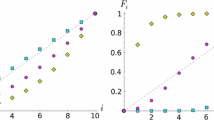Abstract
Parker’s model under rare mutation is considered when there is a finite set of available strategies. The question of when all of those strategies are present in the stationary distribution, i.e., the Markov chain is irreducible, is addressed, via graph theoretic and combinatorial entities. Specific cases for \(n=3,4,5,6\) are addressed, in the first three cases all the feasible cases are specified, and for \(n=6\) a superset of the feasible cases (possibly the set itself) is given.






Similar content being viewed by others
References
Bigalke RC (1972) Observations on the behaviour and feeding habits of the springbok Antidorcas marsupialis. Zool Africana 7:333–359
Cannings C (1990) Topics in the theory of conflicts, NATO Advanced Studies Institute, Montreal. Mathematical and statistical developments of evolutionary theory. Kluwer, London
Cannings C (2013) The stationary distribution of a class of Markov chains. Appl Math 4:769–773
Cressman R (1992) The stability concept of evolutionary games. Springer, Berlin
Haigh J (1975) Game theory and evolution. Adv Appl Prob 7:8–11
Hofbauer J, Sigmund K (1998) Evolutionary games and population dynamics. University Press, Cambridge
Parker GA (1984) Evolutionary stable strategies. In: Krebs JR, Davies NB (eds) Behavioural ecology: an evolutionary approach, 2nd edn. Blackwell, Oxford, pp 30–61
Parker GA, Lessells CM, Simmons LW (2012) Sperm competition games: a general model for pre-copulatory male–male behaviour. Evolution 67:95–109
van Lint JH, Wilson RM (2001) A course in combinatorics. University Press, Cambridge
Zeeman EC (1981) Dynamics of evolution of animal conflicts. J Theor Biol 89:249–270
Acknowledgments
Support is acknowledged from the European Union through funding under FP7-ICT-2011-8 project HIERATIC (316705).
Author information
Authors and Affiliations
Corresponding author
Rights and permissions
About this article
Cite this article
Cannings, C. Combinatorial Aspects of Parker’s Model. Dyn Games Appl 5, 263–274 (2015). https://doi.org/10.1007/s13235-014-0103-5
Published:
Issue Date:
DOI: https://doi.org/10.1007/s13235-014-0103-5




